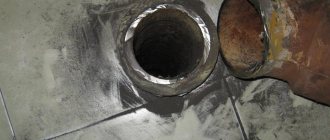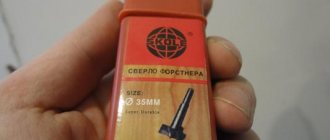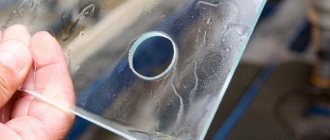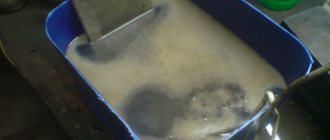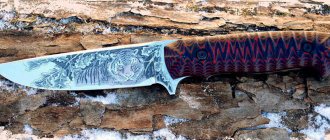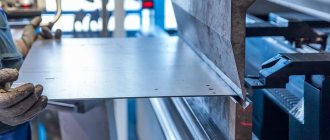It is not difficult to drill ordinary steel or any other metal; standard drills made of high-speed material are used for this. Drilling through hardened steel is another matter: it requires some work. After hardening, the workpiece acquires extraordinary strength, and the question arises of how to drill a hole in hardened metal, because in this case an ordinary drill can no longer help much.
Experts recommend making holes in the parts before hardening occurs. You can also try tempering the steel, then drill and harden the material again. If this is economically justifiable and technically feasible, then this should be done, but in some cases it is simply impossible to do otherwise than proceed to obtain a channel on an already hardened surface.
There are several methods that allow you to drill holes of any diameter in hardened metal. These methods can be implemented with great success both in production and in the home workshop.
Methods for drilling holes in hardened metal
How to drill a hole in hardened metal using acid, a welding machine, special drills and what additional tools are needed for this. Which drills work best with hardened steel?
It is not difficult to drill ordinary steel or any other metal; standard drills made of high-speed material are used for this. Drilling through hardened steel is another matter: it requires some work. After hardening, the workpiece acquires extraordinary strength, and the question arises of how to drill a hole in hardened metal, because in this case an ordinary drill can no longer help much.
Experts recommend making holes in the parts before hardening occurs. You can also try tempering the steel, then drill and harden the material again. If this is economically justifiable and technically feasible, then this should be done, but in some cases it is simply impossible to do otherwise than proceed to obtain a channel on an already hardened surface.
There are several methods that allow you to drill holes of any diameter in hardened metal. These methods can be implemented with great success both in production and in the home workshop.
Size control
After obtaining the holes, size control is carried out. A caliper is used for measurements. If the hole made has ledges, or the length of the measuring jaws of the caliper is not enough to measure the size of the hole, gauges (measuring plugs) are used. These are two measuring cylinders. One of them is equal to the diameter of the hole, the second is 0.3 mm larger. During measurement, a cylinder “to size” is immersed in the “eye”, but the second one should not enter there. In case of piece production, such calibers can be made yourself. In production, instruments with high measurement accuracy are used.
Methods for drilling hardened steel
Drilling hardened steel is characterized by high heating of the surface of the workpiece and tool, which leads to rapid wear of the latter. Therefore, during processing, they try to remove excess heat or make the area where the channel will be softer.
The first method, which allows you to make hot metal more pliable, is based on the use of acids. Suitable substances may include nitric, perchloric or sulfuric acid. These liquids are used pointwise, that is, they are used to treat specifically the place where there will be a hole in the future (the area is etched). To prevent the acid from leaving the working area from materials not exposed to acid (polymers, paints, paraffin), something like a side is organized around the future hole. The hole is filled with active liquid and left for a certain time. Next, drill with a regular drill.
The easiest way, but not the cheapest, is to purchase a special drill designed for making holes in hardened metal. The cutting edges of such a tool are reinforced with pobedit tips or made of pobedit plates. In this case, it is also desirable to use additional cooling of the work area.
When working with acids, you need to be extremely careful and perform the operation in a well-ventilated area. This will help prevent burns or poisoning from harmful fumes.
In production
To drill thicker hardened workpieces, special machines are used. In them, the drill is mounted in a special drill chuck, which is secured with a conical tail in the tailstock quill. Drilling work is carried out thanks to the linear feed of the drill and the quill feed wheel. At the same time, both the workpiece and the drill rotate. The maximum usable drill diameter is 1.5 centimeters. Large drills are secured with a tail with adapter sleeves. They come in standard sizes. They are called Morse cones.
Drills are:
- Spiral with cylindrical and conical shanks. They can drill not only hardened steel, but also cast iron, as well as other “strong” materials;
- With inserts made of carbide materials. Also suitable for thick, hardened steel;
- Deep drill bits. They are used in cases where a hole is made with a depth of 5 times the diameter of the drill.
Before work, the surface of the workpiece is processed. A recess is also made with a centering drill. Otherwise, the drill begins to “walk” in front of the steel sheet, and the hole moves away from the central axis of rotation.
The depth of the hole is controlled by notches with markings on the quill. If there is a dial on it, then the drilling depth will be accurate to 0.01 millimeters. Drilling must be done in several stages. Having made a hole 2 mm deep, the drill is removed from the steel and chips are removed (from the hole and drill outlet channels). After which the process continues. If you do not follow this technology, the drill may jam and break. Don't forget to use lubricant.
Before you start drilling, you must remember that the diameter of the hole is larger than the diameter of the drill. This value is called breakdown. For a drill with a diameter of 1 centimeter, the breakdown will be 0.15 millimeters. Splitting occurs due to insufficient precision during drill sharpening.
To obtain a high-quality hole, the first step is to use a drill whose size is 70% of the diameter of the required hole. At the second stage, it is changed and the required size is used. More precise processing is obtained using countersinking and reaming.
Application of lubricants
- The drilling area on hardened metal is marked with a core. Apply a small amount of lubricant to this point. If it is liquid, then squeeze out a drop of oil so that it does not spread.
- The cutting area of the tool is dipped into the lubricant and placed at the previously marked point.
- When drilling hardened metal, monitor the amount of lubricant and add it as it is used up.
- Monitor the heating status of the instrument, preventing it from overheating. Intensive smoke emission from burning lubricant indicates the need to stop work and cool the equipment and metal.
Brands of drills for hardened steel
Steel grade R6M5K5 is a domestically produced material, where there is less tungsten, only 6%, but its deficiency is compensated by the use of the cobalt element in the alloy (up to 5%). Cobalt also contributes to the strength of the equipment and the ability to withstand increased thermal loads for a long time when working with hardened materials.
Among foreign analogues of high-speed steels suitable for the production of drills for hardened metal, it is worth noting the HSS-Co brand. This is, in fact, the same tool as the previous one, where there is a similar composition of the main alloy elements.
Any drills for porcelain stoneware are also suitable for making holes in hardened metal, only their pobedite tips need to be sharpened.
Drilling rolled steel
Drilling holes in metal is one of the types of mechanical processing to produce through and blind holes of the required diameter. The essence of the process is to secure the workpiece, marking and processing with manual or automated tools.
Drilling equipment
The type of equipment is chosen depending on the tasks assigned. Drilling machines can be radial drilling, vertical drilling, coordinate drilling. With their help they perform:
- through and blind holes with cylindrical walls;
- multifaceted, oval and other holes;
- internal thread;
- finishing;
- drilling an existing hole.
Homemade drill
It is not necessary to buy an expensive drill for the job; in some cases it can be made at home. A cobalt-tungsten alloy rod is best suited for this - it wins. Such a rod is easy to recognize among other pieces of iron: it will not be cut with a metal blade. Then do the following:
- Place a diamond wheel on the emery.
- They trim one side of the rod and grind off slots on this side, like on a flat-head screwdriver.
- Next, grind down the sides to create a sharp cone.
Dear site visitors, please share in the comments your suggestions on how else you can drill a hole in steel that has been hardened.
Source
Devices to facilitate the process
Cutting fluid is used in many types of metal cutting. Most often it is used for deep drilling to reduce friction forces and stabilize the temperature of the working tool. A high-quality liquid does not cause surface corrosion, is safe for humans, does not have an unpleasant odor and removes heat well.
The following is used as a lubricant for drilling metal at home:
- Technical Vaseline – for soft materials.
- Soap solution - for aluminum.
- Turpentine with alcohol - for silumin.
- A mixture of oils - for tool and alloy steels.
Some craftsmen prefer to use a universal composition, which includes laundry soap (200 g) and motor oil (20 g). The components are mixed and boiled until a homogeneous emulsion is obtained.
The use of industrially produced cutting fluids makes it possible to increase the speed of drilling various types of metal. For example, when processing stainless steel, productivity increases by 30%. For cast iron this parameter increases to 40%.
How to drill hardened steel at home
To improve the basic characteristics of the metal, it is often hardened. This technology involves increasing the hardness of the product due to strong heating of the metal and its rapid cooling. In some cases, after heat treatment it is necessary to perform drilling. By increasing this characteristic, drilling hardened metal becomes more difficult. Let's take a closer look at all the features of drilling hardened steel.
Drilling a hole in hardened steel
The widespread question of how to drill through hardened steel can be associated with the fact that when using conventional technology, the tool quickly becomes dull and becomes unusable. That is why you need to pay attention to the features of drilling hardened alloy. Among the features of the technology, we note the following points:
- It is necessary to properly prepare the hardened workpiece.
- In some cases, a special tool is required.
- Coolant is being used.
If necessary, you can make a drill for hardened steel with your own hands, which requires certain equipment and skills. However, in most cases, a purchased version is used, since it will cope better with the task when cutting hardened steel.
Hardened steel drilling process
How to drill with a drill?
Drilling metal with a drill requires following some recommendations:
- To make a hole you will need an electric drill, a core punch, a hammer, machine oil and safety glasses.
- Initially make markings.
- Wear safety glasses.
- When the pressure on the drill is low, you need to select the low speed position and start working.
- Don’t forget to water the area being treated with coolant.
If you follow the technology and use high-quality tools, you can make holes of different diameters and depths. To drill straight holes or accurately select the depth, you can use a device called a “depth stop.” It is attached to an electric drill and adjusted to the desired depth.
Nuances when drilling
The technology in question has a fairly large number of features that need to be taken into account. Drilling of hardened metal is carried out taking into account the following points:
- Before carrying out work, pay attention to the hardness of the surface. This parameter is used to select the most suitable drill. Hardness can be determined using a variety of technologies.
- During drilling, a large amount of heat is generated. This is why rapid wear of the cutting edge occurs. In this regard, in many cases, cooling liquid is supplied to the cutting zone.
- When cutting difficult-to-cut material, it is necessary to sharpen the cutting edge from time to time. For this, a conventional sharpening machine or a special tool is used. Only diamond-coated wheels are suitable as an abrasive.
Steel Drilling Tool
There are a variety of methods for cutting hardened steel. Some of them significantly simplify the processing. Only by taking into account all the nuances can the quality of the resulting hole be improved.
Useful drilling techniques
A variety of technologies can be used to work with hardened steel. The most common technologies are characterized by the following features:
- Surface treatment with acid. This technology is characterized by long-term use, since it takes quite a lot of time to reduce the surface hardness. Sulfuric, perchloric or other acid can be used for etching. The procedure involves creating a lip that will contain the substance used in the cutting zone. After prolonged exposure, the metal becomes softer, and it will be possible to drill using the conventional version.
- You can use a welding machine to achieve your goal. When exposed to high temperatures, the metal becomes softer, which greatly simplifies the procedure.
- Most often, a special drill is used. There are versions on sale that can be used for processing hardened steel. In their manufacture, metal with increased resistance to wear and high temperatures is used. However, the complexity of manufacturing and some other points determine that the cost of a special tool is quite high.
In addition, to achieve this goal, a punch is often purchased. It can be used to make a small hole, which will simplify further drilling.
Metal crown
Large holes in metal, plastic, wood, etc. with a diameter of 19 to 102 mm. Conveniently done using a bimetallic crown from Hilti.
The bits performed very well when drilling a large number of holes for fittings in metal cable boxes (metal thickness 2 mm).
A clear advantage is that the crown is collapsible. If the centering drill becomes dull or breaks, the cost of replacement is about 250 rubles.
But for each diameter you will have to use a separate crown, the price of which (depending on the diameter) is from 400 to 1200 rubles. Add 1000 rubles here. to the adapter.
Use of lubricants
When drilling through hardened steel, serious friction occurs. That is why it is recommended to purchase and use various lubricants. Among the features of this processing method, we note the following points:
- First, the drilling area is processed. A small amount of lubricant is applied to the surface where the hole will be located.
- Oil is added to the cutting edge. To process hardened steel, a small amount of the substance is required, but it must be added from time to time, since it scatters when the tool rotates.
- During work, it is recommended to take breaks to cool the cutting surface and the surface being processed.
Lubricating steel with special oil
Special oil not only simplifies drilling, but also increases the service life of the tool used.
This is because oil can reduce the temperature of the cutting edge.
Working with some types of metal
- When drilling into thick aluminum pieces, chips often clog the drill channels, making it more difficult to rotate. Therefore, when working with such material, remove the drill from the recess more often and remove the chips. Well, don’t forget to pour plenty of oil on it.
- If you need to drill black cast iron, then you do not need to add any lubricating and cooling substances, since it drills very well even dry
- Unlike black cast iron, white cast iron has increased strength, which means strong drills and lubricants are required to process it.
These are the basic rules for drilling metal with a drill. I hope I was able to bridge this gap in your knowledge. Good luck with your homework and see you soon!
Drill selection
Twist drills, which are represented by a vertical rod with two grooves, have become quite widespread. Due to the specific arrangement of the grooves, a cutting edge is formed. Among the features of the choice, we note the following points:
- The pobedite drill bit has become quite widespread. It can be used to work with various hardened alloys. However, a surface with too high hardness cannot be processed with such a tool.
- The choice is also made based on diameter. It is worth considering that it is quite difficult to obtain a large diameter hole. The larger diameter version is much more expensive due to the use of a large amount of material in its manufacture.
- Attention is also paid to the sharpening angle, the purpose of the product and the type of material used in manufacturing. For example, cobalt versions are characterized by higher resistance to high temperatures.
- It is recommended to pay attention to products exclusively from well-known manufacturers. This is due to the fact that Chinese versions are manufactured using low-quality materials. However, such an offer is much cheaper and can be used for short-term or one-time work.
- When choosing a drill, you can be guided by the markings. It can be used to determine which materials were used in production. The diameter of the hole that can be obtained when using the tool is also indicated.
In a specialized store you can find almost everything you need to carry out the work. However, the fairly high cost of the product and some other factors determine that some decide to make a drill themselves from scrap materials. Similar work can be done if you have the required tools.



